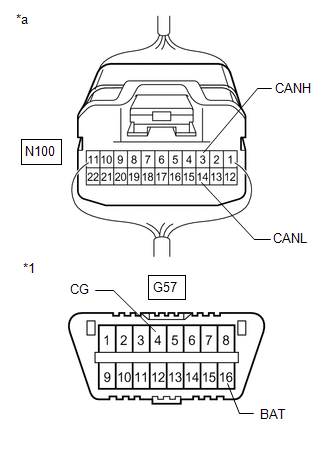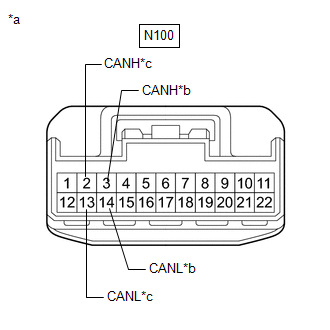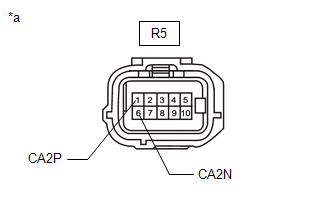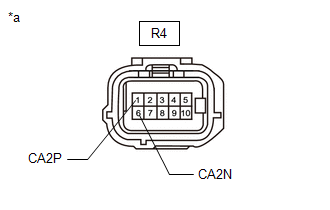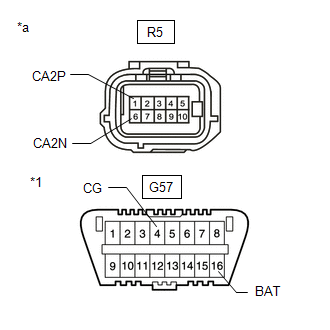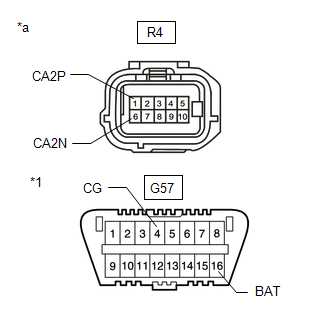Lexus ES: Lost Communication with Blind Spot Monitor Slave Module (U0232)
DESCRIPTION
This DTC is stored when the blind spot monitor sensor RH judges that there is a communication problem with the blind spot monitor sensor LH.
| DTC No. | Detection Item | DTC Detection Condition | Trouble Area |
|---|---|---|---|
| U0232 | Lost Communication with Blind Spot Monitor Slave Module | The blind spot monitor sensor (master) cannot receive signals from the blind spot monitor sensor (slave) |
|
WIRING DIAGRAM
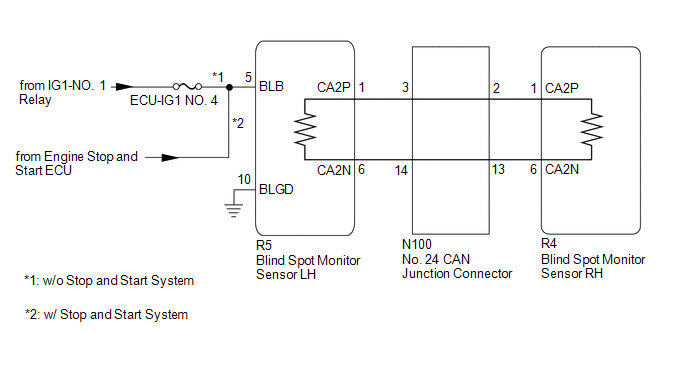
CAUTION / NOTICE / HINT
NOTICE:
- When checking for DTCs, make sure that the blind spot monitor system is turned on.
- Inspect the fuses for circuits related to this system before performing the following procedure.
- Before measuring the resistance of the CAN bus, turn the engine switch off and leave the vehicle for 1 minute or more without operating the key or any switches, or opening or closing the doors. After that, disconnect the cable from the negative (-) battery terminal and leave the vehicle for 1 minute or more before measuring the resistance.
-
After turning the engine switch off, waiting time may be required before disconnecting the cable from the negative (-) battery terminal. Therefore, make sure to read the disconnecting the cable from the negative (-) battery terminal notices before proceeding with work.
Click here
.gif)
.gif)
.gif)
.gif)
HINT:
- Operating the engine switch, any other switches or a door triggers related ECU and sensor communication on the CAN. This communication will cause the resistance value to change.
- Even after DTCs are cleared, if a DTC is stored again after driving the vehicle for a while, the malfunction may be occurring due to vibration of the vehicle. In such a case, wiggling the ECUs or wire harness while performing the inspection below may help determine the cause of the malfunction.
PROCEDURE
| 1. | CONFIRM MODEL |
(a) Choose the model to be inspected.
| Result | Proceed to |
|---|---|
| w/ Parking Support Brake System | A |
| w/o Parking Support Brake System | B |
| B |  | GO TO STEP 3 |
|
| 2. | CHECK DTC OUTPUT (PARKING SUPPORT BRAKE SYSTEM) |
(a) Using the Techstream, check for DTCs according to the prompts on the screen.
Click here .gif)
Standard:
The clearance warning ECU assembly does not output DTCs U0232 and U0233 simultaneously.
| NG |  | GO TO PARKING SUPPORT BRAKE SYSTEM (DTC U0232) |
|
| 3. | CHECK CAN BUS MAIN WIRE |
(a) Turn the engine switch off.
(b) Disconnect the cable from the negative (-) battery terminal.
| (c) Measure the resistance according to the value(s) in the table below. Standard Resistance:
|
|
| Result | Proceed to |
|---|---|
| OK | A |
| Open circuit in CAN main bus lines | B |
| Short circuit between bus lines | C |
| D |
| B |  | GO TO STEP 9 |
| C |  | GO TO STEP 12 |
| D |  | GO TO STEP 15 |
|
| 4. | CHECK HARNESS AND CONNECTOR (BLIND SPOT MONITOR SENSOR LH - BODY GROUND) |
(a) Disconnect the R5 blind spot monitor sensor LH connector.
(b) Measure the resistance according to the value(s) in the table below.
Standard Resistance:
| Tester Connection | Condition | Specified Condition |
|---|---|---|
| R5-10 (BLGD) - Body ground | Always | Below 1 Ω |
| NG |  | REPAIR OR REPLACE HARNESS OR CONNECTOR |
|
| 5. | CHECK HARNESS AND CONNECTOR (BLIND SPOT MONITOR SENSOR LH POWER SOURCE) |
(a) Disconnect the R5 blind spot monitor sensor LH connector.
(b) Measure the voltage according to the value(s) in the table below.
Standard Voltage:
| Tester Connection | Condition | Specified Condition |
|---|---|---|
| R5-5 (BLB) - Body ground | Engine switch on (IG) | 11 to 14 V |
| R5-5 (BLB) - Body ground | Engine switch off | Below 1 V |
| NG |  | REPAIR OR REPLACE HARNESS OR CONNECTOR |
|
| 6. | CHECK DTC |
(a) Reconnect the cable to the negative (-) battery terminal.
(b) Turn the engine switch off.
(c) Turn the engine switch on (IG).
(d) Check for DTCs.
Click here .gif)
OK:
No DTCs are output.
| OK |  | USE SIMULATION METHOD TO CHECK |
|
| 7. | REPLACE BLIND SPOT MONITOR SENSOR LH |
(a) Replace the blind spot monitor sensor LH.
Click here .gif)
.gif)
|
| 8. | RECHECK DTC |
(a) Clear the DTCs.
Click here .gif)
(b) Recheck for DTCs and check if the same DTC is output again.
Body Electrical > Blind Spot Monitor Master > Trouble CodesOK:
No DTCs are output.
| OK |  | END |
| NG |  | REPLACE BLIND SPOT MONITOR SENSOR RH |
| 9. | CHECK FOR OPEN IN CAN BUS MAIN WIRE (NO. 24 CAN JUNCTION CONNECTOR) |
| (a) Disconnect the N100 No. 24 CAN junction connector. |
|
(b) Measure the resistance according to the value(s) in the table below.
Standard Resistance:
| Tester Connection | Condition | Specified Condition |
|---|---|---|
| N100-3 (CANH) - N100-14 (CANL) | Cable disconnected from negative (-) battery terminal | 108 to 132 Ω |
| N100-2 (CANH) - N100-13 (CANL) | Cable disconnected from negative (-) battery terminal | 108 to 132 Ω |
| Result | Proceed to |
|---|---|
| OK | A |
| NG (to blind spot monitor sensor LH CAN main wire) | B |
| NG (to blind spot monitor sensor RH CAN main wire) | C |
| A |  | REPLACE NO. 24 CAN JUNCTION CONNECTOR |
| C |  | GO TO STEP 11 |
|
| 10. | CHECK FOR OPEN IN CAN BUS MAIN WIRE (BLIND SPOT MONITOR SENSOR LH) |
(a) Reconnect the N100 No. 24 CAN junction connector.
| (b) Disconnect the R5 blind spot monitor sensor LH connector. |
|
(c) Measure the resistance according to the value(s) in the table below.
Standard Resistance:
| Tester Connection | Condition | Specified Condition |
|---|---|---|
| R5-1 (CA2P) - R5-6 (CA2N) | Cable disconnected from negative (-) battery terminal | 108 to 132 Ω |
| OK |  | REPLACE BLIND SPOT MONITOR SENSOR LH |
| NG |  | REPAIR OR REPLACE CAN MAIN WIRE OR CONNECTOR (BLIND SPOT MONITOR SENSOR LH - NO. 24 CAN JUNCTION CONNECTOR) |
| 11. | CHECK FOR OPEN IN CAN BUS MAIN WIRE (BLIND SPOT MONITOR SENSOR RH) |
(a) Reconnect the N100 No. 24 CAN junction connector.
| (b) Disconnect the R4 blind spot monitor sensor RH connector. |
|
(c) Measure the resistance according to the value(s) in the table below.
Standard Resistance:
| Tester Connection | Condition | Specified Condition |
|---|---|---|
| R4-1 (CA2P) -R4-6 (CA2N) | Cable disconnected from negative (-) battery terminal | 108 to 132 Ω |
| OK |  | REPLACE BLIND SPOT MONITOR SENSOR RH |
| NG |  | REPAIR OR REPLACE CAN MAIN WIRE OR CONNECTOR (BLIND SPOT MONITOR SENSOR RH - NO. 24 CAN JUNCTION CONNECTOR) |
| 12. | CHECK FOR SHORT IN CAN BUS WIRES (NO. 24 CAN JUNCTION CONNECTOR) |
| (a) Disconnect the N100 No. 24 CAN junction connector. |
|
(b) Measure the resistance according to the value(s) in the table below.
Standard Resistance:
| Tester Connection | Condition | Specified Condition |
|---|---|---|
| N100-3 (CANH) - N100-14 (CANL) | Cable disconnected from negative (-) battery terminal | 108 to 132 Ω |
| N100-2 (CANH) - N100-13 (CANL) | Cable disconnected from negative (-) battery terminal | 108 to 132 Ω |
| Result | Proceed to |
|---|---|
| OK | A |
| NG (to blind spot monitor sensor LH CAN main wire) | B |
| NG (to blind spot monitor sensor RH CAN main wire) | C |
| A |  | REPLACE NO. 24 CAN JUNCTION CONNECTOR |
| C |  | GO TO STEP 14 |
|
| 13. | CHECK FOR SHORT IN CAN BUS WIRES (BLIND SPOT MONITOR SENSOR LH) |
(a) Reconnect the N100 No. 24 CAN junction connector.
| (b) Disconnect the R5 blind spot monitor sensor LH connector. |
|
(c) Measure the resistance according to the value(s) in the table below.
Standard Resistance:
| Tester Connection | Condition | Specified Condition |
|---|---|---|
| R5-1 (CA2P) - R5-6 (CA2N) | Cable disconnected from negative (-) battery terminal | 108 to 132 Ω |
| OK |  | REPLACE BLIND SPOT MONITOR SENSOR LH |
| NG |  | REPAIR OR REPLACE CAN MAIN WIRE OR CONNECTOR (BLIND SPOT MONITOR SENSOR LH - NO. 24 CAN JUNCTION CONNECTOR) |
| 14. | CHECK FOR SHORT IN CAN BUS WIRES (BLIND SPOT MONITOR SENSOR RH) |
(a) Reconnect the N100 No. 24 CAN junction connector.
| (b) Disconnect the R4 blind spot monitor sensor RH connector. |
|
(c) Measure the resistance according to the value(s) in the table below.
Standard Resistance:
| Tester Connection | Condition | Specified Condition |
|---|---|---|
| R4-1 (CA2P) -R4-6 (CA2N) | Cable disconnected from negative (-) battery terminal | 108 to 132 Ω |
| OK |  | REPLACE BLIND SPOT MONITOR SENSOR RH |
| NG |  | REPAIR OR REPLACE CAN MAIN WIRE OR CONNECTOR (BLIND SPOT MONITOR SENSOR RH - NO. 24 CAN JUNCTION CONNECTOR) |
| 15. | CHECK FOR SHORT IN CAN BUS WIRES (NO. 24 CAN JUNCTION CONNECTOR) |
(a) Disconnect the N100 No. 24 CAN junction connector.
(b) Measure the resistance according to the value(s) in the table below.
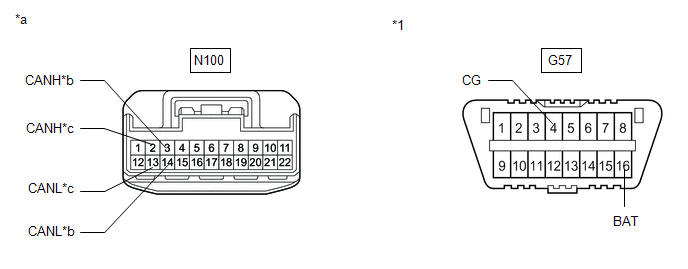
| *1 | DLC3 | - | - |
| *a | Front view of wire harness connector (to No. 24 CAN Junction Connector) | *b | to Blind Spot Monitor Sensor LH CAN main wire |
| *c | to Blind Spot Monitor Sensor RH CAN main wire | - | - |
Standard Resistance:
| Tester Connection | Condition | Specified Condition |
|---|---|---|
| N100-3 (CANH) - G57-4 (CG) | Cable disconnected from negative (-) battery terminal | 200 Ω or higher |
| N100-14 (CANL) - G57-4 (CG) | Cable disconnected from negative (-) battery terminal | 200 Ω or higher |
| N100-3 (CANH) - G57-16 (BAT) | Cable disconnected from negative (-) battery terminal | 6 kΩ or higher |
| N100-14 (CANL) - G57-16 (BAT) | Cable disconnected from negative (-) battery terminal | 6 kΩ or higher |
| N100-2 (CANH) - G57-4 (CG) | Cable disconnected from negative (-) battery terminal | 200 Ω or higher |
| N100-13 (CANL) - G57-4 (CG) | Cable disconnected from negative (-) battery terminal | 200 Ω or higher |
| N100-2 (CANH) - G57-16 (BAT) | Cable disconnected from negative (-) battery terminal | 6 kΩ or higher |
| N100-13 (CANL) - G57-16 (BAT) | Cable disconnected from negative (-) battery terminal | 6 kΩ or higher |
| Result | Proceed to |
|---|---|
| OK | A |
| NG (to blind spot monitor sensor LH CAN main wire) | B |
| NG (to blind spot monitor sensor RH CAN main wire) | C |
| A |  | REPLACE NO. 24 CAN JUNCTION CONNECTOR |
| C |  | GO TO STEP 17 |
|
| 16. | CHECK FOR SHORT IN CAN BUS WIRES (BLIND SPOT MONITOR SENSOR LH) |
(a) Reconnect the N100 No. 24 CAN junction connector.
(b) Disconnect the R5 blind spot monitor sensor LH connector.
| (c) Measure the resistance according to the value(s) in the table below. Standard Resistance:
|
|
| OK |  | REPLACE BLIND SPOT MONITOR SENSOR LH |
| NG |  | REPAIR OR REPLACE CAN MAIN WIRE OR CONNECTOR (BLIND SPOT MONITOR SENSOR LH - NO. 24 CAN JUNCTION CONNECTOR) |
| 17. | CHECK FOR SHORT IN CAN BUS WIRES (BLIND SPOT MONITOR SENSOR RH) |
(a) Reconnect the N100 No. 24 CAN junction connector.
(b) Disconnect the R4 blind spot monitor sensor RH connector.
| (c) Measure the resistance according to the value(s) in the table below. Standard Resistance:
|
|
| OK |  | REPLACE BLIND SPOT MONITOR SENSOR RH |
| NG |  | REPAIR OR REPLACE CAN MAIN WIRE OR CONNECTOR (BLIND SPOT MONITOR SENSOR RH - NO. 24 CAN JUNCTION CONNECTOR) |


